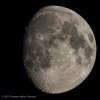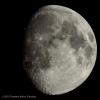Blog
THE MOON IS A POPULAR PHOTOGRAPHING SUBJECT (29.09.2015)
Toomas-Vahur Lihtmaa’s passion is visual arts. He thinks that photography is a good opportunity to express one’s thoughts and feelings in a visual language. Important part of his activities is dedicated to teaching photography and art to little photographers at children art school
When looking at the moon, we are first able to notice its ”seas”. Moving clockwise direction from the top, we see the Sea of Rains, Sea of Cleverness, Sea of Tranquillity, Sea of Crisis, Sea of Fecundity and Sea of Nectar. To the left, at eight o’clock, there are Sea of Clouds and Sea of Moisture. There is a Gassendi crater in the latter that offers a lot a beauty when photographing it and that is why it is my favourite. In addition, two other craters also catch attention – Tycho at the bottom and Copernicus at the top.
The Sea of Tranquillity got its name hundreds of years ago, but man’s foot stepped on the surface of it only in 1969. So, there is a long way to the Sea of Tranquillity. Looking at the photo above, a question arises how long is the way focal length wise? The technical data of the photo: focal length 700mm, shutter speed 1/250, aperture F8, ISO 100, camera Nikon D750, lens AF-S NIKKOR 200-500mm f/5.6E ED VR + AF-S tele converter TC-14E II. This photo could be clearer and sharper because out of convenience, this photo has been taken in the middle of the city and without a tripod. On the other hand, this fact says a lot good about the stabilizer of the lens and about photo quality. I’m sure, Nikon 1 J5 20.8 MP BSI sensor would give a very detailed results which combined with this equipment should make the focal lenght 1890 mm. But unfortunately it doesn’t because J5 together with FT-1 adapter does not support using this lens. But, Nikon 1 AW1 camera did not have anything against this lens and the moon was again 1190mm closer focal length wise than on the last photo. These two photos are taken with Nikon 1 AW1 camera at 1/400 F8 ISO 400



